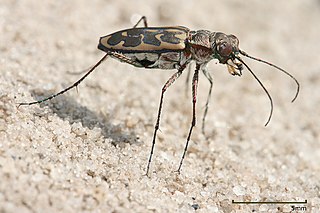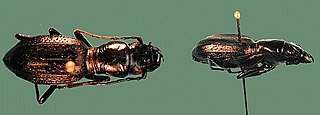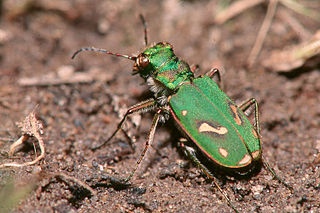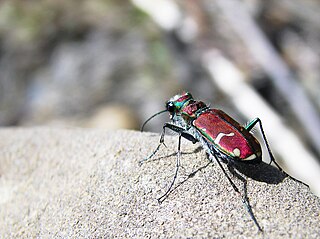
Cordia is a genus of flowering plants in the borage family, Boraginaceae. It contains about 300 species of shrubs and trees, that are found worldwide, mostly in warmer regions. Many of the species are commonly called manjack, while bocote may refer to several Central American species in Spanish. The generic name honours German botanist and pharmacist Valerius Cordus (1515–1544). Like most other Boraginaceae, the majority have trichomes (hairs) on the leaves.

Tiger beetles are a family of beetles, Cicindelidae, known for their aggressive predatory habits and running speed. The fastest known species of tiger beetle, Rivacindela hudsoni, can run at a speed of 9 km/h, or about 125 body lengths per second. As of 2005, about 2,600 species and subspecies were known, with the richest diversity in the Oriental (Indo-Malayan) region, followed by the Neotropics. While historically treated as a subfamily of ground beetles (Carabidae) under the name Cicindelinae, several studies since 2020 indicated that they should be treated as a family, the Cicindelidae, which are a sister group to Carabidae within the Adephaga.

Dynastes tityus, the eastern Hercules beetle, is a species of rhinoceros beetle native to the Eastern United States. The adult's elytra are green, gray or tan, with black markings, and the whole animal, including the male's horns, may reach 60 mm (2.4 in) in length. The larvae feed on decaying wood from various trees.

Coral Pink Sand Dunes State Park is a state park in southwestern Utah, United States, located between Mount Carmel Junction and Kanab, south and west of U.S. Highway 89 in Kane County. The park features uniquely pink-hued sand dunes located beside red sandstone cliffs.

The six-spotted tiger beetle, also known as the six-spotted green tiger beetle, is a common North American species of Tiger beetles in the Cicindelinae subfamily. It is common in many areas of the states, and is well known. It is recognized for its bright green color and its flight pattern. They're usually harmless and live up to 3 years.

Cicindela, commonly known as common tiger beetles are generally brightly colored and metallic beetles, often with some sort of patterning of ivory or cream-colored markings. They are most abundant and diverse in habitats very often near bodies of water with sandy or occasionally clay soils; they can be found along rivers, sea and lake shores, sand dunes, around dry lakebeds, on clay banks, or woodland paths.

Amblycheila cylindriformis is a species of flightless tiger beetle. It shares its genus with at least five other species in the United States, with a few more found in Mexico.

Amblycheila is a genus of flightless, nocturnal tiger beetles. There are eight species distributed across the southwestern United States and Mexico.

Cicindela ohlone, the Ohlone tiger beetle, is endemic to California. It was discovered in 1987 and named and described in 1993. C. ohlone is most closely related to Cicindela purpurea.
Cicindela columbica is a species of beetle in the tiger beetle subfamily, Cicindelinae, known commonly as the Columbia River tiger beetle. It is endemic to Idaho in the United States.

Minidoka National Wildlife Refuge is located on the Snake River Plain in south-central Idaho, 12 miles (19 km) northeast of Rupert. It includes about 80 miles (130 km) of shoreline around Lake Walcott, from Minidoka Dam upstream about 25 miles (40 km).

Cicindela limbalis, the common claybank tiger beetle, is a species of tiger beetle. The length of the beetle is 12–16 millimeters (0.5–0.6 in). The beetle's back is reddish purple and sometimes may be dull green or brown. The species can commonly be found on steep, moist bare clay soil. The beetle can live for 3 years.

The Brachypsectridae are a family of beetles commonly known as the Texas beetles. There are only two extant genera, Brachypsectra and Asiopsectra. Brachypsectra has a cosmopolitan distribution, mostly in arid regions, while Asiopsectra is found in Central Asia and the Middle East.
The Coffin Cave mold beetle, also known as the Inner Space Caverns mold beetle, is a small insect that is only found in caves. They are very small at 2.60–2.88 mm (0.102–0.113 in) and lack any form of eyes. They are found exclusively in caves in a single county in Texas, Williamson County. The United States Fish and Wildlife Service considers the Coffin Cave mold beetle to be an endangered species. Threats facing this species include urbanization.

Dendroctonus frontalis, the southern pine beetle, is a species of bark beetle native to the forests of southern United States, Mexico and Central America. It has a hard reddish brown to black exoskeleton and measures approximately 3 mm (0.12 in), about the size of a grain of rice. It is short-legged, the front of the males head is notched, the female possesses a wide elevated transverse ridge, and the hind abdomen of both is round.

Copelatus chevrolati is a species of diving beetle. It is part of the genus Copelatus in the subfamily Copelatinae of the family Dytiscidae. It was described by Aubé in 1838. There are two described subspecies: C. c. chevrolati and C. c. renovatus.

Copelatus glyphicus is a species of diving beetle. It is part of the genus Copelatus in the subfamily Copelatinae of the family Dytiscidae. It was described by Say in 1823.

Cicindela depressula, the dispirited tiger beetle, is a species of flashy tiger beetle in the family Carabidae. It is found in North America.

Habroscelimorpha dorsalis, commonly known as the eastern beach tiger beetle, is a species of flashy tiger beetle in the family Carabidae. It is found in Central America and North America.

Cicindela punctulata, the punctured tiger beetle, is a species of tiger beetle commonly found across much of the United States, southeastern Canada, and in parts of northern Mexico.

















